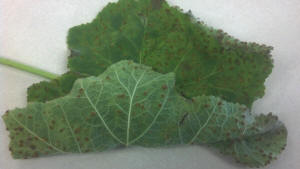|
 Column Column
Rust on Hollyhocks, Mosquitoes, and West
Nile and Zika Viruses
By John Fulton
 Send a link to a friend
Send a link to a friend
[May 23, 2016]
Rust on Hollyhocks - Hollyhocks
are one of the traditional, old-fashioned flowers often grown in our
area. This year, they are definitely interesting. Even before the
flowers open. Most area hollyhocks are infected with rust. Rust is
usually a spring and fall disease problem, when it does occur.
|
|
 leaves, and the
top side of the leaves has some rather striking bright yellow to
orange spots develop. Rust can attack all plant parts including
leaves, stems, and leaf petioles. The rust disease spends the
winter in old plant parts on the ground. Removal of the plant
material will help reduce infection possibilities. Increasing
air flow and reducing humidity will also help. Control is best
accomplished by removing infected leaves at the first sign of
the rust (on the bottom of the leaves). Chemical control may
needed, and sprays containing sulfur are effective. leaves, and the
top side of the leaves has some rather striking bright yellow to
orange spots develop. Rust can attack all plant parts including
leaves, stems, and leaf petioles. The rust disease spends the
winter in old plant parts on the ground. Removal of the plant
material will help reduce infection possibilities. Increasing
air flow and reducing humidity will also help. Control is best
accomplished by removing infected leaves at the first sign of
the rust (on the bottom of the leaves). Chemical control may
needed, and sprays containing sulfur are effective.
Mosquitoes, West Nile Virus, and Zika Virus
West Nile Virus (WNV) has, unfortunately, become a household
phrase. Add in a newer virus called Zika, and mosquito control
is more important than ever. WNV harms humans, birds, and other
animals. It is transmitted by infected mosquitoes, primarily the
northern house mosquito for WNR, and most often is from
mosquitoes feeding on infected birds. The Zika virus is
transmitted from infected people, and the Aedes mosquito is one
vector. The Zika virus is deemed to be in light to moderate
availability in our area of the country in the July to September
period by the Center for Disease Control.
The mosquito life cycle has four life stages (egg, larvae, pupa,
and adult). The female mosquito lays eggs on water or moist
soil. Most of the larvae hatch after 48 hours and the larvae and
pupae live in the water. The females need a blood meal before
they can lay eggs, so only the females bite. They bite every few
days during their adult lives, which may last several weeks.
Preventing mosquitoes is a first step. Homeowners can best
accomplish this by eliminating standing water. Tires and old
containers are obvious places to start, drill holes in the
bottom of recycling containers, clean clogged gutters, donít
allow stagnant water in anything such as birdbaths, change
landscape slopes to eliminate standing water, and use larvacides
in standing water that canít be eliminated. B.t. Israeli is the
strain that is effective against mosquito larvae Ė not the B.t.
variety commonly used on trees and gardens! Larval stages may be
found in standing water, so treatment time is at hand.
[to top of second column] |

Also protect yourself from bites. Mosquitoes can travel up
to three miles from their breeding sites! Make sure that screens
and doors are tight, use proper outside lighting such as
fluorescent lights, stay indoors at dawn and dusk when
mosquitoes are most active, wear long-sleeved shirt and long
pants when you must go outside, and use insect repellents
properly applied. Exposed skin should be sparingly treated with
a repellent containing up to 30% DEET (up to 10% for children),
and make sure to treat thin clothing as well (since mosquitoes
can bite through the thin clothing).
[By JOHN FULTON, COUNTY EXTENSION
DIRECTOR SERVING LOGAN, MENARD, AND SANGAMON COUNTIES]

 |